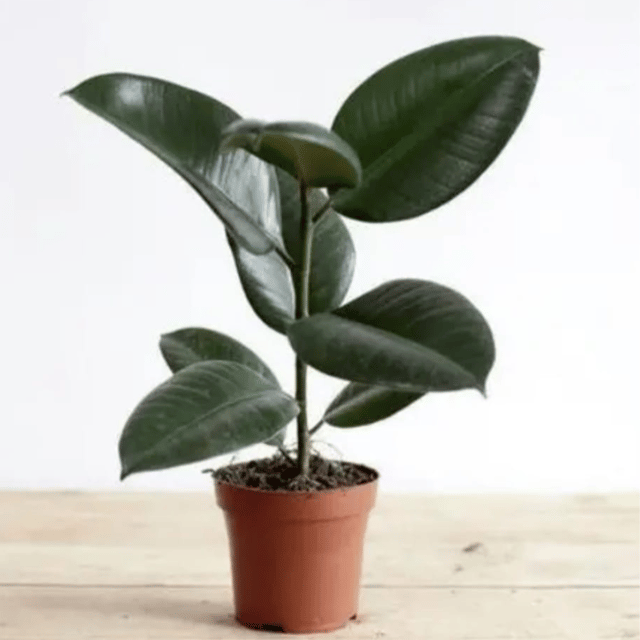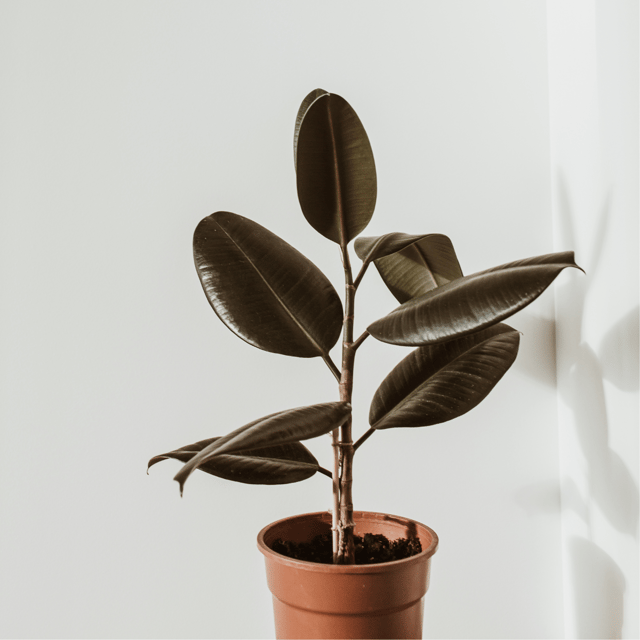Currency
Language
Rubber Plant
Everything You Need to Know About Rubber Plants
Rubber Plants (scientifically known as Ficus elastica) are a favorite among plant lovers for their elegant appearance, low-maintenance care, and air-purifying qu...
Everything You Need to Know About Rubber Plants
Rubber Plants (scientifically known as Ficus elastica) are a favorite among plant lovers for their elegant appearance, low-maintenance care, and air-purifying qualities. Whether you’re a plant enthusiast or a beginner, Rubber Plants are a wonderful addition to any indoor space, bringing both aesthetic and health benefits. This comprehensive guide will cover everything you need to know about Rubber Plants, from their benefits and varieties to care tips, vastu significance, and how to buy them online.
Introduction to Rubber Plants
Rubber Plants belong to the fig family and are native to the tropical forests of Southeast Asia. They became popular as indoor plants due to their hardiness and their ability to thrive in indoor environments with minimal care. With their large, glossy leaves and ability to adapt to various light conditions, Rubber Plants make an excellent choice for homes, offices, and apartments.
Rubber Plants are also well-known for their air-purifying qualities. They are capable of removing harmful toxins like formaldehyde from the air, making them ideal for improving indoor air quality.
Rubber Plant Benefits
Air-Purifying Qualities
One of the most significant benefits of Rubber Plants is their ability to purify indoor air. They help remove toxins such as formaldehyde, benzene, and carbon monoxide, making your living environment healthier. Rubber Plants also increase humidity, which can alleviate dry skin and respiratory issues caused by dry air, particularly in air-conditioned homes.
Boosting Indoor Humidity
As Rubber Plants release moisture into the air, they help to maintain higher humidity levels in your home. This is particularly beneficial during dry seasons or in air-conditioned environments, where the air can become too dry and cause discomfort.
Stress Relief and Aesthetic Appeal
Having plants indoors can greatly reduce stress and promote a sense of well-being. The Rubber Plant’s large, glossy leaves have a calming, aesthetic appeal, which can improve the ambiance of your home or office, making it a more relaxing and peaceful place.
Positive Impact on Mental Health
Indoor plants like Rubber Plants contribute to mental well-being by bringing nature indoors. Studies show that being around plants can reduce stress, improve mood, and enhance productivity, making them a perfect companion in workspaces and homes alike.
Rubber Plant vs. Rubber Tree Plant
It’s easy to confuse Rubber Plants with Rubber Trees, but they are distinct in several ways.
Rubber Plant (Ficus elastica)
Rubber Plants, commonly grown as houseplants, are small to medium-sized and have large, thick leaves. They are ideal for indoor décor due to their manageable size and low-maintenance nature.
Rubber Tree (Hevea brasiliensis)
Rubber Trees, on the other hand, are large tropical trees known for producing natural rubber. While they’re typically grown for commercial purposes, they can also be planted outdoors in large gardens or used as landscaping trees in tropical climates.
Popular Indoor Varieties
The most common types of Rubber Plants used for indoor decoration include the Ficus elastica varieties, which are prized for their elegant look and ease of care. Varieties like Burgundy and Variegated Rubber Plants are especially popular for indoor spaces.
Popular Varieties of Rubber Plants
Rubber Plants come in various types, each with unique characteristics. Whether you want a pop of color or a sleek, minimalist look, there’s a Rubber Plant variety to suit your style.
Burgundy Rubber Plant
This variety features dark green leaves that often appear almost black or burgundy under certain light conditions. Its bold, dramatic look makes it a great choice for modern interiors.
Variegated Rubber Plant
The Variegated Rubber Plant, also known as Ficus elastica ‘Tineke’, has beautiful green, cream, and pink variegated leaves. Its striking appearance adds a touch of elegance to any room.
Ficus Elastica ‘Robusta’
This type of Rubber Plant is known for its large, thick, glossy leaves, which give it a robust and bold appearance. It’s one of the most popular varieties due to its minimal care requirements and attractive foliage.
Ficus Elastica ‘Ruby’
This variety has stunning reddish-pink hues on its leaves, which makes it a unique and eye-catching choice for plant enthusiasts who want something vibrant for their home.
Rubber Plant Vastu: Incorporating it Into Your Home or Office
In Vastu Shastra, the Rubber Plant is considered a symbol of wealth, prosperity, and good health. It is believed that placing a Rubber Plant in the right location within your home or office can help attract positive energy and improve overall well-being.
Best Placement for Rubber Plants
According to Vastu, placing a Rubber Plant in the southeast corner of your home or office promotes financial growth and prosperity. The plant’s broad, round leaves are thought to symbolize wealth and abundance.
Positive Energy and Harmony
Rubber Plants also contribute to a harmonious environment by balancing the energies in a room. Their presence is said to promote peace and relaxation, making them ideal for bedrooms and living areas.
Rubber Plant Propagation Guide
Rubber Plants are relatively easy to propagate, making them a great option for plant lovers who want to grow their collection.
Step-by-Step Guide to Propagating Rubber Plants
- Choose a Healthy Cutting: Select a healthy stem with at least one or two leaves.
- Make the Cut: Using sterilized scissors or a knife, cut just below a node (the part where the leaf meets the stem).
- Prepare the Cutting: Remove any lower leaves from the stem.
- Root in Water or Soil: You can either place the cutting in water or plant it directly in soil. If using water, change it every few days to prevent bacterial growth.
- Provide Proper Conditions: Keep the cutting in bright, indirect light and ensure it stays moist but not waterlogged.
- Wait for Roots: Within a few weeks, roots should start to develop. Once the roots are established, you can plant the cutting in a pot with well-draining soil.
Common Issues During Propagation
Rubber Plants are prone to root rot if overwatered, so be careful not to let the cutting sit in soggy soil. Slow growth can occur if the plant doesn’t receive enough light.
Rubber Plant Care Tips
Rubber Plants are low-maintenance, but proper care will help them thrive and look their best.
Light Requirements
Rubber Plants prefer bright, indirect light. They can tolerate low-light conditions, but their growth may slow, and the leaves may lose some vibrancy. Place your Rubber Plant near a window that receives filtered sunlight for the best results.
Watering Practices
Rubber Plants like their soil to dry out between waterings. Water only when the top inch of soil feels dry to the touch. Be careful not to overwater, as Rubber Plants are susceptible to root rot.
Humidity and Dusting
These plants appreciate moderate humidity levels, but they can also thrive in standard indoor environments. Wipe the leaves regularly with a damp cloth to keep them free of dust and promote healthy growth.
Common Pests
Rubber Plants are generally pest-resistant, but they can sometimes attract mealybugs or spider mites. Treat infestations by wiping the leaves with a cloth dipped in soapy water or using insecticidal soap.
Pruning and Repotting
To maintain your Rubber Plant’s shape and size, prune it during the growing season. Repot the plant every two years to refresh the soil and give the roots more space.
Rubber Plant: Indoor Benefits for Health and Wellness
Rubber Plants not only enhance the aesthetic appeal of your home but also provide several health benefits.
Improving Air Quality
Rubber Plants are excellent air purifiers, helping to filter out toxins and improve the quality of indoor air. This makes them an ideal choice for homes, especially in urban areas where air pollution can be an issue.
Increased Oxygen Levels
By photosynthesizing, Rubber Plants increase oxygen levels in the room, which can enhance focus and productivity. This makes them a great addition to workspaces or study areas.
Stress Relief
The calming presence of plants like the Rubber Plant has been shown to reduce stress levels, making them beneficial for mental well-being.
Best Practices for Transplanting
Once your plant arrives, allow it to acclimate to its new environment for a few days before transplanting. Choose a pot with drainage holes and use well-draining soil to prevent root rot.
Where to Buy Rubber Plants Online
At Paudhewale, you’ll find a wide variety of Rubber Plants available for purchase, ranging from small tabletop plants to larger, statement-making varieties.


